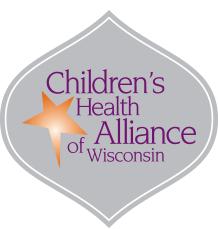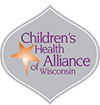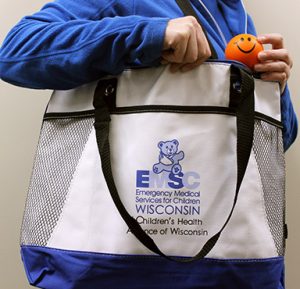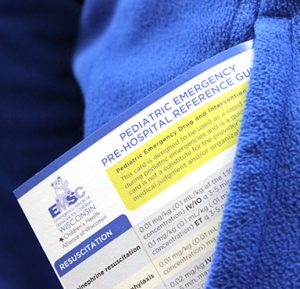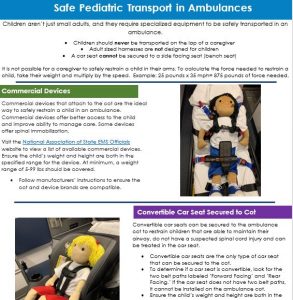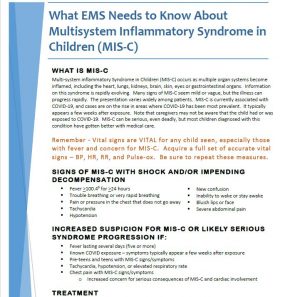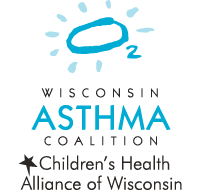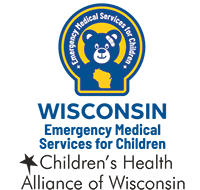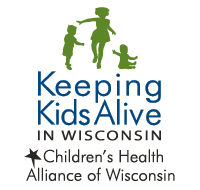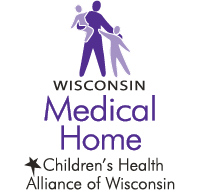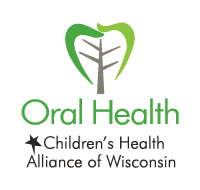Prehospital Readiness
Prehospital Readiness
Though pediatric ambulance runs are infrequent for most Wisconsin EMS agencies, they often are very critical situations. Children are not tiny adults. That’s why it’s important for your EMS agency to be pediatric ready.
In 2020 the American Academy of Pediatrics, American College of Emergency Physicians, Emergency Nurses Association, National Association of Emergency Medical Services Physicians, and National Association of Emergency Medical Technicians issued a joint policy statement, “Pediatric Readiness in Emergency Medical Services Systems.”
Use the Prehospital Pediatric Readiness EMS Agency Checklist to learn if your EMS agency is ready to care for children as recommended in the Policy Statement.
Pediatric Emergency Care Coordinators (PECCs)
PECCs are EMS team members who ensure the pediatric perspective is included at their agencies. PECCs communicate with emergency departments and coordinate pediatric injury prevention activities and education. Wisconsin EMSC is committed to increasing the number of PECCs in the state.
Prehospital Resources from Wisconsin EMSC
Pediatric Comfort Kit
The Pediatric Comfort Kit contains items to soothe, comfort and distract kids during an emergency. Every emergency response team and emergency department should have a pediatric comfort kit on hand.
Pediatric Prehospital Reference Guide
Children need specialized assessment, equipment and medication dosages. Use the Pediatric Prehospital Reference Guide for fast facts during pediatric emergencies.
Pediatric Safe Transport Handout
Children aren’t just small adults, and they require specialized equipment to be safely transported in an ambulance. This handout will guide EMS providers to safely transport children in ambulances.
MIS-C and EMS
MIS-C impacts multiple organs and is associated with COVID-19. Signs can seem mild or vague but the illness can progress rapidly. This document will guide you through what MIS-C is, signs, symptoms and how to treat it.
Prehospital Pediatric Readiness Resources
Equipment for Ground Ambulances
The American Academy of Pediatrics, the National Association of State EMS Officials, EMSC and other partners have developed this list of essential pediatric equipment for ground ambulances.
Equipment for Ground Ambulances – 2014 Joint Policy Statement
This statement includes a recommended core list of supplies and equipment that should be stocked on ground ambulances to provide the accepted standards of patient care.
Family-Centered Prehospital Care: Partnering with Families to Improve Care
This resource includes practical tips for providing family-centered prehospital care.
Ground and Air Medical Quality in Transport (GAMUT) Metrics
The GAMUT metrics are patient-centric and most are based on medical literature demonstrating an improvement in patient outcomes.
Kansas Pediatric Scenario Guidebook
This guidebook includes various scenarios containing vital signs, pertinent patient and call information, graphics, considerations and links for additional educational opportunities.
Medical Direction Toolbox
This toolkit provides guidance for physician medical directors and EMS administrators on the roles and responsibilities of the EMS medical director and the incorporation of pediatrics into EMS medical oversight.
National EMS Quality Alliance Measure Set
In August 2019, the NEMSQA Measure Development Committee and Board of Trustees approved the eleven measures for inclusion in the National EMS Quality Alliance Measure Set to help EMS agencies measure improvement in care.
National Model EMS Clinical Guidelines – National Association of State EMS Officials
These guidelines were developed by the National Association of State EMS Officials (NASEMSO) to facilitate the creation of state and local EMS system clinical guidelines, protocols, or operating procedures.
Patient- and Family-Centered Care Toolbox
Use these resources to ensure that patient and family perspectives, choices, knowledge, values, beliefs and cultural backgrounds are incorporated into the planning and delivery of care.
Pediatric Disaster Preparedness Toolbox
In a disaster, it’s important to have appropriate pediatric equipment and supplies, medical oversight, protocols and guidelines, and training in the care of children.
Pediatric Equipment Toolbox
This toolbox provides the most recent guidelines, resources, position papers and journal articles on pediatric equipment guidelines.
Pediatric Pain Management Toolbox
The assessment and management of pediatric pain can be a real challenge for health care providers. Learn how to better understand, assess and relieve children’s pain in prehospital settings.
Pediatric Prehospital Education Toolbox
Identify educational needs, develop curricula and establish standards to ensure prehospital professionals have the knowledge and skills necessary to provide safe, effective, family-centered emergency care for children.
Prehospital Pediatric Readiness Toolkit
These tools and resources are aligned with the Joint Policy Statement and will assist prehospital emergency care providers to better understand and achieve the components of pediatric readiness in the prehospital environment.
Standards of Care Manual – Milwaukee County Office of Emergency Management
This manual includes medical policies, operational guidelines, practice guidelines and practical skills meant to guide prehospital medical care provided within Milwaukee County EMS systems.
Contact Our Staff
Carissa Brunner, MPH, CLC
Program Leader
Emergency Care
(414) 266-4773
cbrunner@childrenswi.org
Sign Up for Our Newsletter
1-2-3 EMSC
A quarterly newsletter highlighting pediatric emergency care news and events.
Emergency Medical Services for Children is funded by the Wisconsin Department of Health Services, Division of Public Health, through the National Emergency Medical Services for Children program, administered by the Health Resources and Services Administration’s Maternal and Child Health Bureau.
